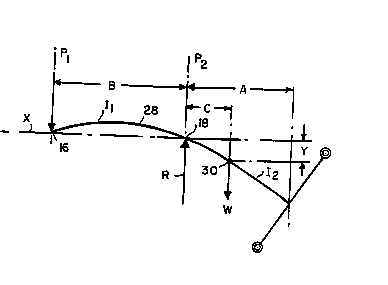Some of the information on this Web page has been provided by external sources. The Government of Canada is not responsible for the accuracy, reliability or currency of the information supplied by external sources. Users wishing to rely upon this information should consult directly with the source of the information. Content provided by external sources is not subject to official languages, privacy and accessibility requirements.
Any discrepancies in the text and image of the Claims and Abstract are due to differing posting times. Text of the Claims and Abstract are posted:
| (12) Patent: | (11) CA 2145459 |
|---|---|
| (54) English Title: | HIGH SPEED LAYING HEAD |
| (54) French Title: | TETE DE LAMINOIR ULTRARAPIDE |
| Status: | Term Expired - Post Grant Beyond Limit |
| (51) International Patent Classification (IPC): |
|
|---|---|
| (72) Inventors : |
|
| (73) Owners : |
|
| (71) Applicants : |
|
| (74) Agent: | SMART & BIGGAR LP |
| (74) Associate agent: | |
| (45) Issued: | 1999-01-12 |
| (22) Filed Date: | 1995-03-24 |
| (41) Open to Public Inspection: | 1995-10-27 |
| Examination requested: | 1995-03-24 |
| Availability of licence: | N/A |
| Dedicated to the Public: | N/A |
| (25) Language of filing: | English |
| Patent Cooperation Treaty (PCT): | No |
|---|
| (30) Application Priority Data: | ||||||
|---|---|---|---|---|---|---|
|
A rolling mill laying head as a quill supported for rotation about its longitudinal axis
between axially spaced first and second bearing assemblies. A laying pipe is carried by the quill
for rotation therewith. The laying pipe has an entry section lying on the quill axis between the
first and second bearing assemblies, and a three dimensionally curved intermediate section
extending through and beyond the second bearing assembly to terminate at a delivery end spaced
radially from the quill axis to define a circular path of travel. The dimension by which the
laying pipe extends beyond the second bearing assembly is less than the diameter of the circular
path.
Tête de laminoir à fourreau supportée, aux fins de rotation, sur son axe longitudinal entre un premier et un deuxième roulements séparés axialement. Un conduit est porté par le fourreau pour en assurer la rotation. Le conduit présente une section d'entrée réalisée sur l'axe du fourreau, entre les premier et deuxième roulements, et une section intermédiaire tridimensionnelle courbée passant dans le deuxième roulement et en ressortant, pour se terminer à une extrémité de sortie espacée radialement de l'axe du fourreau de manière à constituer une voie d'acheminement circulaire. La dimension du conduit sortant du deuxième roulement est inférieure au diamètre de la voie circulaire.
Note: Claims are shown in the official language in which they were submitted.
Note: Descriptions are shown in the official language in which they were submitted.

2024-08-01:As part of the Next Generation Patents (NGP) transition, the Canadian Patents Database (CPD) now contains a more detailed Event History, which replicates the Event Log of our new back-office solution.
Please note that "Inactive:" events refers to events no longer in use in our new back-office solution.
For a clearer understanding of the status of the application/patent presented on this page, the site Disclaimer , as well as the definitions for Patent , Event History , Maintenance Fee and Payment History should be consulted.
| Description | Date |
|---|---|
| Inactive: Expired (new Act pat) | 2015-03-24 |
| Letter Sent | 2010-12-07 |
| Letter Sent | 2010-12-07 |
| Inactive: Office letter | 2010-05-18 |
| Inactive: Office letter | 2010-05-18 |
| Revocation of Agent Request | 2010-03-09 |
| Appointment of Agent Request | 2010-03-09 |
| Inactive: IPC from MCD | 2006-03-11 |
| Grant by Issuance | 1999-01-12 |
| Pre-grant | 1998-08-27 |
| Inactive: Final fee received | 1998-08-27 |
| Notice of Allowance is Issued | 1998-03-10 |
| Letter Sent | 1998-03-10 |
| Notice of Allowance is Issued | 1998-03-10 |
| Inactive: Status info is complete as of Log entry date | 1998-03-05 |
| Inactive: Application prosecuted on TS as of Log entry date | 1998-03-05 |
| Inactive: Approved for allowance (AFA) | 1998-02-11 |
| Application Published (Open to Public Inspection) | 1995-10-27 |
| Request for Examination Requirements Determined Compliant | 1995-03-24 |
| All Requirements for Examination Determined Compliant | 1995-03-24 |
There is no abandonment history.
The last payment was received on 1998-03-04
Note : If the full payment has not been received on or before the date indicated, a further fee may be required which may be one of the following
Patent fees are adjusted on the 1st of January every year. The amounts above are the current amounts if received by December 31 of the current year.
Please refer to the CIPO
Patent Fees
web page to see all current fee amounts.
Note: Records showing the ownership history in alphabetical order.
| Current Owners on Record |
|---|
| SIEMENS INDUSTRY, INC. |
| Past Owners on Record |
|---|
| HAROLD E. WOODROW |
| TERENCE M. SHORE |